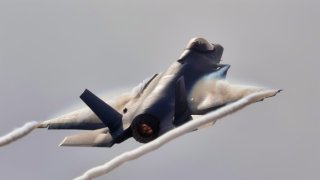Meet the 'Tomcats': The U.S. Marines Now Have More F-35C Stealth Fighters
The United States Marine Corps (USMC) reached a significant milestone as its Marine Fighter Attack Squadron 311 (VMFA-311), known as the "Tomcats," achieved initial operational capability (IOC) with the F-35C Lightning II, the carrier-capable variant of the Joint Strike Fighter.
Summary and Key Points: The United States Marine Corps (USMC) reached a significant milestone as its Marine Fighter Attack Squadron 311 (VMFA-311), known as the "Tomcats," achieved initial operational capability (IOC) with the F-35C Lightning II, the carrier-capable variant of the Joint Strike Fighter.
-Based at Marine Corps Air Station Miramar, California, the squadron was reactivated in April 2023 as part of the USMC's transition to a fully fifth-generation aircraft force.
-Achieving IOC marks the squadron's readiness to perform essential missions, including close air support, anti-air warfare, and electronic attacks.
-The Tomcats completed extensive training, including over 900 air sorties and 1,700 flight hours, to reach this milestone.
The USMC's Tomcats Have Reach IOC With the F-35
The United States Marine Corps hit a major milestone on Wednesday as a second carrier-capable F-35C squadron achieved initial operational capability (IOC). The Marine Fighter Attack Squadron 311 (VMFA-311), known as the "Tomcats" and based out of Marine Corps Air Station Miramar, California, was actually decommissioned as VMA-311 in October 2020 and then reactivated in April 2023 as the service made the transition to a force consisting fully of fifth-generation aircraft.
The West Coast unit has been working with VMFA-314 as it transitioned to the Lockheed Martin F-35C Lightning II, the carrier-capable variant of the U.S. military's Joint Strike Fighter.
Notable past members of the squadron included baseball legend Ted Williams, and astronaut and later United States Senator John Glenn.
F-35 IOC for Marines: A Major Milestone
Reach the IOC has been a key milestone for the squadron, which can trace its linage back to December 1942 when it was first raised as Marine Fighting Squadron 311 (VMF-311), and based out of Marine Corps Air Station Cherry Point, North Carolina. Before beginning the transition to the fifth-generation stealth multirole fighter, VMFA-311 operated the McDonnell Douglas AV-8B Harrier II and Boeing F/A-18 Hornet.
According to the Marine Corps, with the IOC qualification, "VMFA-311 has the operational F-35C Lightning II aircraft, trained pilots, maintainers, and support equipment to sustain its mission essential tasks. These tasks include close air support, strike coordination, and reconnaissance, anti-air warfare, suppression of enemy air defenses and electronic attacks."
To prepare for the milestone, the unit flew more than 900 air sorties, totaling around 1,700 hours. In addition, the squadron's Marine Corps aviators completed more than 800 simulator hours, while the ground crew conducted 2,4000 maintenance actions.
"Initial operational capability is a milestone and achievement in readiness," said Lt. Col. Michael Fisher, commanding officer of VMFA-311, "It's all on the backs of the Marines out there. What they do in their day-to-day actions is what made this possible."
The Marine Corps further stated that beyond reaching the IOC, the Tomcats took part in training with "the most advanced aviation schools offered by the U.S. Navy and Marine Corps."
Maj. Timothy Potter, an F-35C pilot with VMFA-311 was noted to have graduated from the U.S. Navy Strike Fighter Tactics Instructor Program – aka "TOPGUN." Potter has become the squadron's pilot instructor, which will increase VMFA-311's ability to train its other aviators. In addition, the Marine Corps announced that "Warrant Officer John Page, an aviation ordnance officer, graduated from the Marine Corps Weapons and Tactics Instructor Course. Marines completed lightning tactics instructor qualifications, air combat maneuvering qualifications, division lead, and section lead qualifications."
The Tomcats will next reach full operational capability (FOC) after it receives its complete complement of ten of the fifth-generation aircraft, which is currently projected for fiscal year 2025 (FY25).
"Nothing changes for us, our pursuit of excellence and how we carry ourselves, initial operational capability is a byproduct of daily competency and being good at our job," Fisher. "It is a great accomplishment, but when we wake up the next day, we are going to keep doing the same thing. Now full operational capability is the goal."
A Historic Unit – With Many Notable Firsts
Since being raised more than 80 years ago, the Marine Corps fighter squadron has flown several significant aircraft beginning with the F4U Corsair, and later including the F9F Panther, F9F Cougar, A-4 Skyhawk, AV-8B Harrier II, and now the F-35C Lightning II.
"VMFA-311 was one of the first Marine Corps squadrons to transition to jet aircraft with the F9F Panther," the Marine Corps further stated.
In 2020, the then-VMA-311 deactivated the last of its Harriers as it prepared for the transition to then become the second of the service's F-35C squadrons.
"As a previous F/A-18 Hornet pilot, the F-35 is our bid for success for the future," Fisher said. "It is where the Marine Corps is going for TACAIR."
In addition to the second F-35C squadron, the United States Marine Corps also has eight operational F-35B – the short/vertical takeoff and landing (S/VTOL) variant – squadrons and two training squadrons. Combined the squadrons operate more than 100 F-35Bs.
Author Experience and Expertise: Peter Suciu
Peter Suciu is a Michigan-based writer. He has contributed to more than four dozen magazines, newspapers, and websites with over 3,200 published pieces over a twenty-year career in journalism. He regularly writes about military hardware, firearms history, cybersecurity, politics, and international affairs. Peter is also a Contributing Writer for Forbes and Clearance Jobs. You can follow him on Twitter: @PeterSuciu. You can email the author: [email protected].
Image Credit: Creative Commons and/or Shutterstock.


